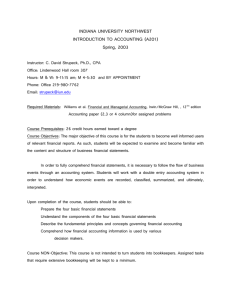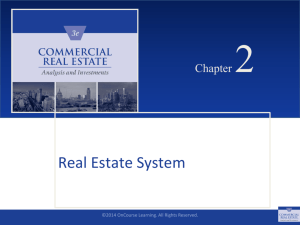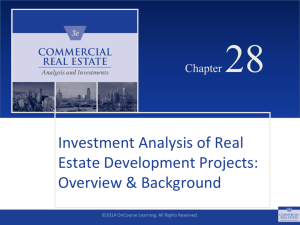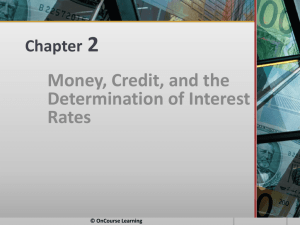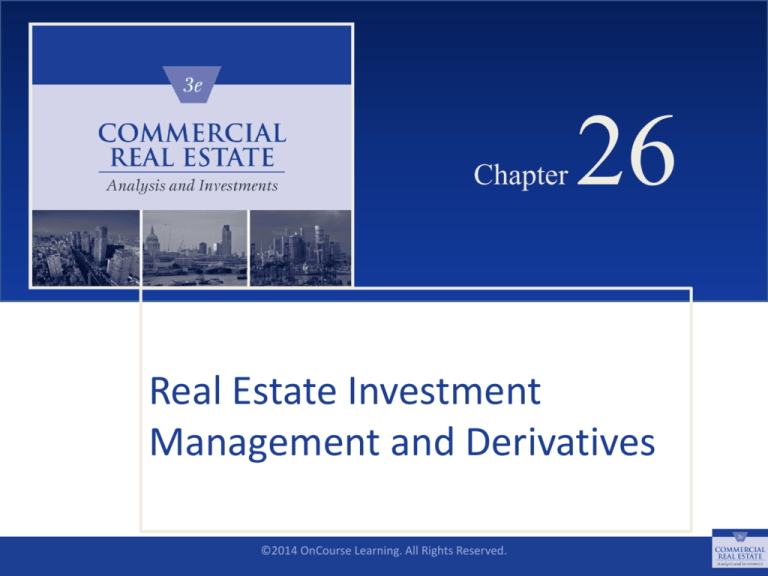
CHAPTER
26
Chapter
26
Real Estate Investment
Management and Derivatives
SLIDE 1
©2014 OnCourse Learning. All Rights Reserved.
CHAPTER
26
CHAPTER OUTLINE
26.1 Macro-Level Investment Performance Attribution
26.1.1 The Importance of Property-Level Investment Management
26.1.2 Macro Property-Level Performance Attribution and the Four
Fundamental Responsibilities
26.1.3 Portfolio-Level Performance Attribution
26.1.4 Use of a Benchmark in Performance Attribution
26.1.5 The Case for Using Manager Allocation Weights in the Benchmark
26.2 Investment Performance Evaluation and Benchmarking
26.2.1 The Basic Idea
26.2.2 Benchmarks and Investment Styles in the Private Real Estate Asset
Class
26.3 Real Estate Derivatives
26.3.1 How Index Swaps Can Be Used and Priced
26.3.2 The Broader Potential Role of Index Derivatives
26.3.3 Solving the Index Problem
26.4 Chapter Summary
SLIDE 2
©2014 OnCourse Learning. All Rights Reserved.
CHAPTER
26
LEARNING OBJECTIVES
After reading this chapter, you should understand:
What is meant by investment performance attribution at
both the macro property level and the portfolio level.
How to quantify segment allocation versus asset
selection effects in a portfolio’s differential performance
relative to an appropriate benchmark.
What are the major institutional real estate investment
management “styles” and how these may be accounted
for in quantitative investment performance evaluation.
The new concept of real estate equity index derivatives
and how such products might be used in real estate
investment management.
SLIDE 3
©2014 OnCourse Learning. All Rights Reserved.
26.1 Macro-Level Investment Performance
Attribution
SLIDE 4
©2014 OnCourse Learning. All Rights Reserved.
CHAPTER
26
26.1.1 The Importance of Property-Level
Investment Management
SLIDE 5
©2014 OnCourse Learning. All Rights Reserved.
CHAPTER
26
EXHIBIT 26-1 Dispersion of Individual Property Price
Change Around an Aggregate Index: Moody’s/RCA
CPPI and Price Paths of 10 Last-Sold Property
Investments as of June 2012
Pegged to starting
value on index at
time of prior sale
(buy), then tracked
at constant rate per
month to ultimate
sale price deviation
from index at
disposition in June
2012.
Source: Data from Real Capital Analytics Inc. (Used by permission)
SLIDE 6
©2014 OnCourse Learning. All Rights Reserved.
CHAPTER
26
26.1.2 Macro Property-Level Performance
Attribution and the Four Fundamental
Responsibilities
SLIDE 7
©2014 OnCourse Learning. All Rights Reserved.
CHAPTER
26
© OnCourse Learning
EXHIBIT 26-2 The Four Fundamental Property-Level
Investment Management Responsibilities Related
to the Three Property-Level Performance Attributes
CHAPTER
26
SLIDE 8
©2014 OnCourse Learning. All Rights Reserved.
EXHIBIT 26-3 Property-Level IRR Attributes in 42
Round-Trip Investments: Subject Property vs.
NCREIF Cohort, IRR Component by Property
Source: Modified from Feng (2010).
SLIDE 9
©2014 OnCourse Learning. All Rights Reserved.
CHAPTER
26
CHAPTER
26
26.1.3 Portfolio-Level Performance Attribution
SLIDE 10
©2014 OnCourse Learning. All Rights Reserved.
© OnCourse Learning
EXHIBIT 26-4 Returns Realized for Clients by
Bob and Sue
CHAPTER
26
SLIDE 11
©2014 OnCourse Learning. All Rights Reserved.
26.1.4 Use of a Benchmark in Performance
Attribution
SLIDE 12
©2014 OnCourse Learning. All Rights Reserved.
CHAPTER
26
© OnCourse Learning
EXHIBIT 26-5 Sue’s Performance Attribution
Relative to Her Benchmark
CHAPTER
26
SLIDE 13
©2014 OnCourse Learning. All Rights Reserved.
26.1.5 The Case for Using Manager Allocation
Weights in the Benchmark
SLIDE 14
©2014 OnCourse Learning. All Rights Reserved.
CHAPTER
26
26.2 Investment Performance Evaluation and
Benchmarking
SLIDE 15
©2014 OnCourse Learning. All Rights Reserved.
CHAPTER
26
CHAPTER
26
26.2.1 The Basic Idea
SLIDE 16
©2014 OnCourse Learning. All Rights Reserved.
CHAPTER
26
© OnCourse Learning
EXHIBIT 26-6 Graphical Depiction of Typical
Investment Manager Performance Evaluation
SLIDE 17
©2014 OnCourse Learning. All Rights Reserved.
26.2.2 Benchmarks and Investment Styles in
the Private Real Estate Asset Class
SLIDE 18
©2014 OnCourse Learning. All Rights Reserved.
CHAPTER
26
EXHIBIT 26-7 NCREIF/Townsend Fund Indices vs.
NCREIF Property Index: Cumulative Total Returns,
2000–2012
CHAPTER
26
© OnCourse Learning
Based on
value-weighted
all-funds indices,
net of fees. NPI is
property level
gross of fees.
SLIDE 19
©2014 OnCourse Learning. All Rights Reserved.
EXHIBIT 26-8 NCREIF/Townsend Report of Real Estate
Opportunistic Funds IRR Performance by Vintage Year
(as of March 31, 2012)
Source: NCREIF and The Townsend Group, “Real Estate Fund Indices and Vintage Period Performance
Report, 1st Quarter 2012f,” NCREIF, Chicago, 2012.
SLIDE 20
©2014 OnCourse Learning. All Rights Reserved.
CHAPTER
26
CHAPTER
26
© OnCourse Learning
EXHIBIT 26-9 Schematic Diagram of Institutional
Real Estate Investment Management Styles
SLIDE 21
©2014 OnCourse Learning. All Rights Reserved.
CHAPTER
26
26.3 Real Estate Derivatives
SLIDE 22
©2014 OnCourse Learning. All Rights Reserved.
26.3.1 How Index Swaps Can Be Used and
Priced
SLIDE 23
©2014 OnCourse Learning. All Rights Reserved.
CHAPTER
26
CHAPTER
26
© OnCourse Learning
EXHIBIT 26-10 Example Index Swap Contract
SLIDE 24
©2014 OnCourse Learning. All Rights Reserved.
26.3.2 The Broader Potential Role of Index
Derivatives
SLIDE 25
©2014 OnCourse Learning. All Rights Reserved.
CHAPTER
26
EXHIBIT 26-11
Potential Role of
Index Derivatives
within the Real
Estate Investment
System to Facilitate
Greater Flexibility
and Specialization
via Synthetic
Investment and Risk
Management
Hedging
SLIDE 26
©2014 OnCourse Learning. All Rights Reserved.
© OnCourse Learning
CHAPTER
26
CHAPTER
26
26.3.3 Solving the Index Problem
SLIDE 27
©2014 OnCourse Learning. All Rights Reserved.
EXHIBIT 26-12 Cumulative Total Returns of FTSE
NAREIT PureProperty Indices Compared to NCREIF
NTBI for Four Regional Target Segments,
2000–2012
This exhibit shows this
relationship for four major
geographic regional indices,
comparing the cumulative
total return of the
PureProperty Index with
that of the corresponding
transaction based NTBI.
Source: FTSE and NCREIF data.
SLIDE 28
©2014 OnCourse Learning. All Rights Reserved.
CHAPTER
26
CHAPTER
26
26.4 Chapter Summary
SLIDE 29
©2014 OnCourse Learning. All Rights Reserved.
CHAPTER
26
KEY TERMS
performance attribution
benchmarking
macro property level (performance
SLIDE 30
attribution)
property selection
acquisition transaction execution
operational management during the
holding period
disposition transaction execution
portfolio level (performance
attribution)
allocation
selection
segments (in the asset market)
benchmark
interaction effect
performance evaluation
peer universe
passive index
active management
fund-level indices
investment styles
core
value-added
opportunistic
vintage
sample
population
derivative
synthetic investment
covered long
hedge
covered short
alpha
stock market based property return
indices (SMPRIs)
©2014 OnCourse Learning. All Rights Reserved.

